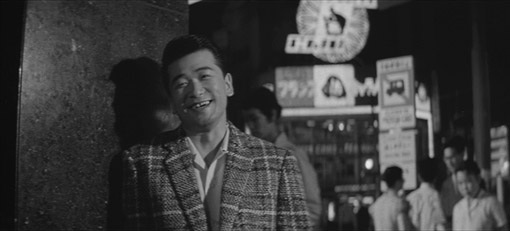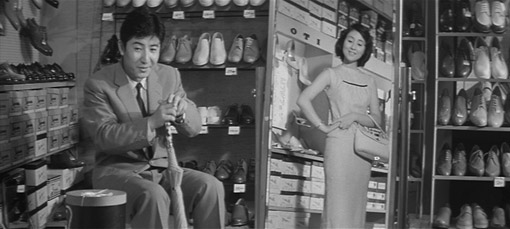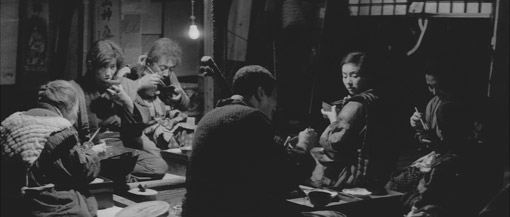|
Continuing Masters of Cinema's ongoing mission to make just about every film by Japanese maestro Imamura Shôhei available on DVD and Blu-ray, this latest release headlines his 1963 The Insect Woman [Nippon konchûki], rightly regarded as one of the key films of the Japanese New Wave. But it also includes Imamura's lesser known (and rarely seen) second feature, the 1958 Nishi-Ginza Station [Nishi Ginza ekimae], which although could technically be classified as an extra feature, really plays as one half of an Imamura double-header, and as it was made first...
| Nishi-Ginza Station [Nishi Ginza ekimae] |
|
More than once I've been dismissive of the commonly held belief that self-referential cinema is a recent phenomenon, given that it's actually been with us since the earliest days of film as an entertainment and artistic medium. Of course, what was once a cinematic rarity has since become very much part of modern film language. Characters now regularly reference other film and television works as if they live in our world and share our viewing habits, and we no longer bat an eyelid when a character acknowledges the camera and talks directly to the audience. But to have someone do so in a Japanese comedy-drama made in 1958 by Imamura Shôhei does tend to catch you a little by surprise.
Consider the opening scene. The camera drifts up after a dolly shot of a walking woman's legs to the face of a cheerful and quiff-haired singer (played by hugely popular singing star Frank Nagai, who would have been instantly recognisable to a Japanese audience of the time), who enthuses about Ginza (a celebrated and once trendy shopping district), asks us where we're from, and then calls off-screen for music – in English, no less – to kick off his self-penned theme song. Following brief opening titles that play out on an electronic ticker display, the song is continued by everyone from leaping pedestrians to a policeman and his cheerless and cuffed prisoner. It climaxes in an almost operatic turn by a station official at the titular Ginza station and the reappearance of the Singer, this time in railway uniform, standing on a step-ladder correcting the station clock. A few seconds later he's knocked from his perch by two exuberant children whose apologetic parents, the Singer informs us, are the story's main protagonists. The Singer pops up intermittently throughout the film to comment on the action, the fourth wall collapsing when his end-of-story round-up is overhead by the very couple about whom he is talking.

The pair in question are the mild-mannered Ôyama and his more assertive wife Riko, a pragmatic woman who runs the pharmacy at which her husband works and who is clearly the boss of this particular household. It's a situation the conciliatory Ôyama appears to wearily accept, unlike his more gregarious friend Asada, a cheerful womanising veterinarian who chides Ôyama for letting Riko walk all over him – "You'll regret it on your death bed," he assures him. When their wives go out of town for a couple of days, Asada takes Ôyama out for a night on the town in the hope that he'll meet a woman with whom he can have an affair. "Not the best person to be giving marriage counselling advice," observes The Singer in one of his many guises as a food stall salesman. In the course of the evening the two get royally plastered, but are seen safely home by a young woman named Yuri, who works at the pen shop (that's not a typo – they sell pens) across the road from the pharmacy. The following day Ôyama plucks up the courage to ask Yuri out, and to his surprise and mild alarm she eventually accepts. But does the inexperienced Ôyama have the confidence to take this first date to its logical conclusion?
Imamura's second feature is a frothy comedy-drama that sits rather oddly in the director's filmography and is a work Imamura himself would later recall with a tinge of embarrassment. The plot is neither substantial nor particularly original (take a look what Billy Wilder did with the same basic concept three years earlier in The Seven Year Itch), and the fifty minute running time leaves little room for subplots or real character development. But if you can forget that you're watching an Imamura film (and it's actually not that hard) then Nishi-Ginza Station is actually rather fun, a lightweight but often briskly handled entertainment that plays a few small games with film form (speeded-up motion, silent movie farce) and turns traditional concepts of patriarchal Japanese households on their head. Blows are repeatedly delivered to Ôyama's sense of self-worth, from the string of visiting sales reps uninterested in talking to anyone but the shop's (and, by implication, Ôyama's) absent boss, to the pharmacy worker instructed by Riko to ensure that her husband drinks his tomato juice on time and to phone her if he refuses. Unwilling to upset his humdrum status quo, Ôyama intermittently escapes by daydreaming himself to the South Sea Islands and an idealised romance with native girl Sally, a fantasy (or perhaps, it is at one point suggested, a treasured memory) that show signs of being realised through his pursuit of the facially identical Yuri.

Narratively the film is a little anaemic, moving bumpily in the third act towards a late story revelation that time has rendered unsurprising, though the story itself does come to a somewhat unexpected conclusion (I'd hop forward a paragraph if you want to avoid a major spoiler), at least for those of us raised on contemporary Hollywood takes on the temptations of infidelity. There's no worm-turning emergence of Ôyama's quashed machismo, nor does he undergo an emotional epiphany regarding his love for his wife. Instead he returns to a life of social emasculation, a state of glum tolerance made bearable only by the continuance of unfulfilled South Sea Island dreams.
But Nishi-Ginza Station still has its pleasures and a few genuinely funny moments (the sequence in which Ôyama is given dating advice by Asada's bumbling assistant really made me laugh), a breezy and good-natured early work from a director who three years later would really establish his auteur credentials with the far more ambitious Pigs and Battleships [Buta to gunkan]. It's with that in mind that Nishi-Ginza Station should perhaps be viewed as more a sketchbook of ideas than a fully formed whole, a film whose rice-paper plot and comical tone allowed a young and adventurous filmmaker to play some interesting and entertaining games with style and form.
| The Insect Woman [Nippon konchûki] |
|
If Nishi-Ginza Station is generally seen as Imamura-light, then his 1964 The Insect Woman [Nippon konchûki] is regarded as one of his most important films. It is also a more instantly recognisable Imamura work, in its focus on those living on the outskirts of regular society, in the strong female characters (men very much play the supporting role here), in the key role played by sex, and in the range of characters that the audience are required to keep tabs on. That last one in particular can prove a real challenge here, particularly for non-Japanese viewers required to make sense of unfamiliar cultural aspects as they're joining the dots. This is especially true of the film's first twenty minutes, where key plot points are tucked away in sometimes throwaway dialogue and almost three decades of family history are covered in a series of brief and narratively disconnected vignettes. Here you really do need to listen to every line, make a note of every name and how each are connected, and keep them all on instant recall if you're going to avoid getting lost.
Eventually emerging as the central character is Tome, whose devoted father Chûji is a couple of sticks short of a bundle and may well not be her father at all. A few brief blink-and-you'll-miss-something scenes later and she's old enough to be married off to local landowner's son Shunzô in order to clear a family debt. A short while after that she's back home and pregnant and we pick up in passing that Chūji has given Sunzô a beating. A reminder of the harshness of life pre-war rural Japan is provided when Tome gives birth to a girl and the local midwife calmly asks Tome's mother En, "Let it live or get rid of it?" and En chooses the latter. "Another mouth to feed," she complains gruffly, but Tome successfully pleads for the child's life to be spared.

As well as keeping tabs of the characters you'll also be expected to take note of the social and historical context in which all this takes place, often from what you infer rather than what is openly stated. Thus the arrival of war is indicated more by the all-female factory workforce and the scrurry following an air raid warning than any specific announcement, and is confirmed by Shunzô's aggressive seduction of Tome, which he justifies as the right of a man who may soon die in battle. Key dates are provided, but it's left to us to understand their social significance marry them to the brief snippets of news footage they accompany.
It's in the post-WW2 scenes that the pace starts to settle down, though even here the time and location jumps will likely catch the less attentive on the hop. It's an approach that one minute has Tome working and sleeping with union organiser Matsunami at the local factory, and the next on a bus counting her severance pay. Seconds after this she's left home for Tokyo and is working as a maid for the westernised Midori and her unseen American husband. One tragic accident later and she's confessing her sins as a member of the Pure Land Buddhism Sect, which leads to a job as a maid at a hotel run by women offering a very specific service to its all-male clientele. Tricked into serving a client by the owner Madam Suma, Tome accuses her employer of turning hungry women into slaves, but is seduced by the pay, and another temporal jump later is earning good money as a seasoned pro, if you'll pardon the expression.
Imamura's determination to create a form of "disorderly cinema" does sometimes make the film feel like it's been cut down from a longer work, one with a more gradual story development and whose key events and characters were explored in more detail. But while this would certainly have made it easier for an unprepared audience to find its feet, it would also rob the film of its most structurally exciting and distinctive aspect, one that strips the narrative of all fat to focus solely on key events in Tome's journey, a life shown not precisely as it played out but in the fragmented manner in which it might be remembered. And despite having to repeatedly pause the disc in order to make notes without missing a whole wad of information, I immensely enjoyed the process of connecting the dots and extrapolating key story elements from lines of dialogue that in other films would have functioned primarily as filler. This almost offhand method of imparting information extends to the sometimes eye-opening incidental detail, whether it be the phallus Chûji appears to be carving for the (female) God of the Mountain, or the blood the brothel keep refrigerated for when a client requests the services of an unspoiled virgin.

Possibly more rooted in Imamura's fascination with human sexuality are the quasi-incestuous aspects of Chûji's relationship with his (step?-) daughter Tome. This is at its most blatant when he sucks the poison from a boil on her thigh, which is photographed at an angle that transforms a medical service into an almost sexual act, or when Tome's infant daughter Nobuko refuses to feed and she offers her breast instead to her father to gorge on instead. It's an intimate exchange that a distraught Tome later tries to repeat, the act of loving desperation by a daughter for her dying father. As Nobuko inherits the role once occupied by her mother, there's a strong sense that they are caught in a repeating cycle of birth, growth and death in which only the details change. It's one whose participants remain largely unaffected by national and world events, however cataclysmic, and where the next generation appear to learn not from what they hear but what they observe when looking through doorways, as parental figures collide in conflict or coitus. This cyclic element extends to the geography of the personal journeys, as Tome makes the move from the rural farmland of her birth to an urban environment in which she becomes too settled to imagine going back, a journey her daughter Nobuko looks set to take in her place through the farming collective in which she goes to such lengths to invest.
In an interview with Imamura included on this very disc, noted Japanese critic and film writer Sato Tadao says of The Insect Woman, "Some scenes don't hang together, but that's what makes the film so fascinating," and in this observation he nails just what it is that makes this particular film stand out not just in Imamura's oeuvre, but in contemporary cinema in general. At the time of its release there was nothing quite like it, and it remains to this day a challenging, ambitious and richly rewarding film, one so densely packed with often implicit narrative detail that you can't help but suspect that Imamura's "disorganised cinema" was as meticulous planned and crafted as any film in this singular filmmaker's remarkable career.
Both transfers here have been licensed from Nikkatsu, and we can presume it was they who were responsible for the restoration work done here. Neither transfer hits the imposing heights reached by Masters of Cinema's Blu-ray of Hara-Kiri, but both are still rather impressive, albeit with a few small concessions made to probably imperfect source material.
The level of detail on Insect Woman, while not reference quality, is generally very good, and really comes into its own on daylight exteriors and brightly light interiors, which is also where the contrast and tonal range are at their most impressive. The contrast softens a little in darker interior scenes, with the black levels greying out a little, presumably to rescue shadow detail that might otherwise be lost, though in some cases the detail is not there to begin with. Just occasionally there is also a some small burn-out on the brighter highlights. The print is very clean, with only the odd dust spot still remaining and no evidence of more serious damage repair.

The picture on Nishi-Ginza Station is a tad softer than that of its companion, but once again looks good in the brighter lit scenes. The contrast is slightly stronger than The Insect Woman with more pronounced black levels, but these also grey out when the light level drops. This greying out may well be deliberate in some scenes – when Ôyama and Yuri become lost at sea at night you'd be lucky to see anything if the contrast were boosted. Although it's clearly been cleaned up, there are a fair few dust spots still present throughout.
The DTS-HD Master Audio mono 2.0 soundtracks on both films are inevitably a little narrow in their dynamic range, with a slight treble bias audible on The Insect Woman, but the dialogue is always clear and there's no distortion even on louder sounds and musical notes.
Imamura Interview (20:53)
Imamura Shôhei is interviewed – very likely for Japanese television and on an unspecified date – by Japan's foremost film critic and cinema theorist Sato Tadao. The two men had a long association, with Sato eventually succeeding Imamura as president of the Japan Academy of Moving Images, which Imamura founded, and this is reflected in the friendliness of the chat. Rather than a general interview about Imamura's career, the interview focuses almost exclusively on The Insect Woman and its development, with Sato having as much to say as his interviewee. It's all fascinating stuff and an invaluable inclusion, particularly given that Imamura is no longer with us.
Booklet
The words of Japanese cinema expert Tony Rayns dominate the typically well produced MoC booklet, with separate essays on both films in which he is largely dismissive of Nishi-Ginza Station and proclaims The Insect Woman a masterpiece. Detailed and authoritative, they provide a compelling examination of both films, The Insect Woman in particular, though as ever they should be post-viewing reading if you want to avoid spoilers. Also included are a the main credits for both films, a selection of good quality stills, and reproductions of the original posters.
Another excellent package from Masters of Cinema, boasting one of Imamura's most important and remarkable films, a thematically lightweight but still rather fun early work, a valuable interview with the director, and a fine accompanying booklet. And though a couple of notches short of pristine, the transfers still showcase both films well. Warmly recommended.
|